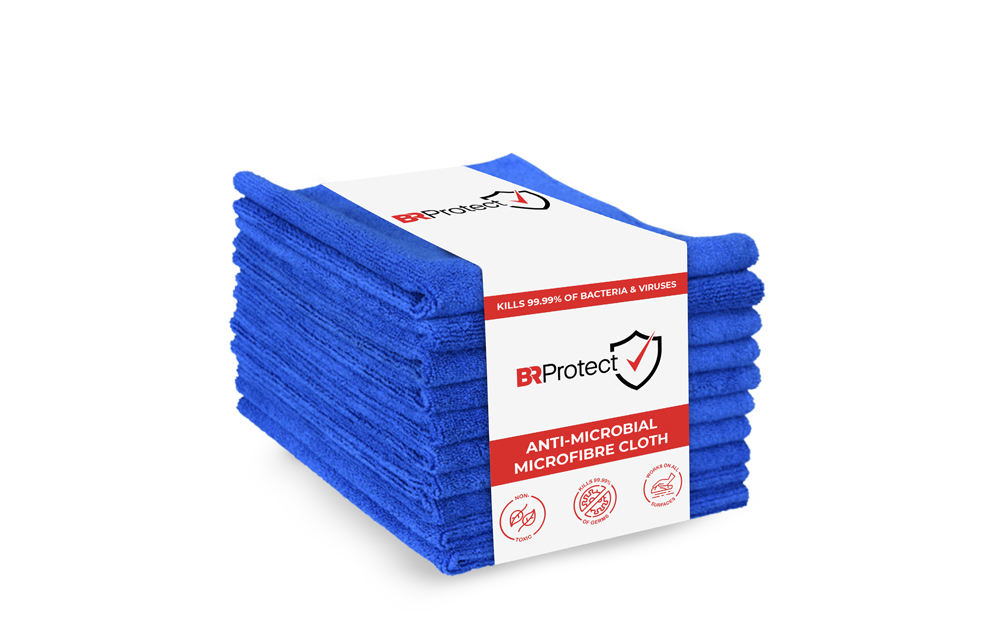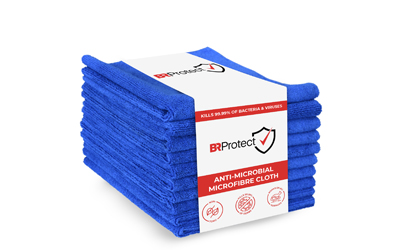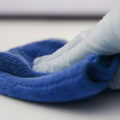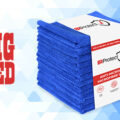It is already a well-known fact that the use of high-quality microfibre cloths can have a profoundly positive impact on cleanliness and hygiene when appropriately used to clean objects and surfaces. Their enhanced ability to clean is due to their physical structure. Microfibre cloths are fabricated from a 50:50 blend of nylon and polyester that has been extruded in such a way that, depending on the quality of the cloth, will have a fibre size ranging between 5 microns in cloths of average quality and down to 0.3 microns or less for premium-quality cloths.

Making the Best Even Better
The smaller the cloths component fibres are in diameter, the smaller the particle size they can attract through electrostatic forces and then trapping those particles within their microscopic woven structure. Therefore, as microfibre cloths cannot electrostatically enmesh dirt, debris or microorganisms smaller than the diameter of their own component fibres, clearly the first step in increasing their efficacy is to fabricate the cloths from strands of material that have the smallest diameter fibres possible. The best, premium-grade cloths on the market will contain fibres that are no greater than 0.3 microns in diameter. Therefore, such high-quality cloths are physically capable of attracting and trapping particles down to this size in diameter. This, by definition, will include at least 99% of pathogenic bacteria and many species of virus too.
Supercharging the antimicrobial properties of microfibre cloths
The ability of microfibre cloths to attract and capture bacteria and viruses is due to the aggregated electrostatic forces created by multitudes of plastic microfibres. Even average microfibre cloths with fibre sizes between 5 and 3 microns in size can be accurately be described as mildly antimicrobial in use. Clearly, reducing their component fibre size by a factor of 10 to no more than 0.3 microns in size will correspondingly increase their antimicrobial properties. However, the most effective way to further enhance their abilities is to impregnate them with a long-lasting residual antimicrobial disinfection agent. This means that the cloth will not just physically trap pathogenic microorganisms, but also effectively destroy or inactivate them on contact!
Therefore, the most efficient antimicrobial cleaning cloths available on the market will be those that are physically woven from fibres with a diameter below 0.3 microns (which based upon their own physical structure would be able to trap 99% of pathogens and thereby deliver a 2-log reduction in the microbial load. However, the second step of impregnating such a high-quality cloth with a broad-spectrum disinfectant would increase this microbial destruction rate to a 4-log reduction thereby eliminating 99.99% of all known disease-causing microorganisms including viruses.
The most suitable disinfectant to impregnate microfibre cloths with is a quaternary based organo-silane. This type of persistent, residual disinfectant can remain efficient and effective in destroying microorganisms on contact for extended periods of time and have been shown to exhibit no signs of degradation in terms of killing power even after being used and laundered over 150 times!

Making Microfibre Cloths Even Safer During and After Use
When a microfibre cloth is efficiently doing what it is intended to do best, small particles of dirt including pathogenic microorganisms will remain electrostatically enmeshed within the microscopic fabric of the cloth until it is next laundered.
Because infectious pathogens will remain trapped within the cloths woven structure, there is a perceived risk that these microorganisms may proliferate whilst residing within the cloth and could then (theoretically) be transferred from one place to another during any further cleaning operations undertaken with the same cloth.
Therefore, impregnating a high-quality microfiber cleaning cloth with a long-lasting residual silane-based disinfectant provides an already efficient cloth with even higher levels of hygiene and safety. Such impregnated cloths not only have the physical ability to attract and then trap pathogens in their structure, but also to destroy or inactivate them immediately upon contact. This eliminates the perceived risk of microbial transfer from one place to another and therefore, the chance of cross-contamination with potentially infectious pathogens.
Using this potent combination of a silane impregnated microfibre cloth means that the only microorganisms trapped within the fibres of the cloth are going to be dead or non-viable. This means that all such cloths will remain completely safe throughout the entire period they are in use as well as while they are waiting to be laundered.
At the point when the cloth is laundered, preferably at a temperature in excess of 60°C along with a mild detergent, the fibres will uncurl and release any already dead microorganisms and particles of dirt into the washing water.
A scientific study recently determined that microfibre cloths impregnated with a silane-based disinfectant can remain at optimal levels of performance for over 150 washes.
Related Posts
- Why Microfibre Cloths Are Undisputedly the Best Choice for Cleaning
- BRProtect: A Game-changer in the Fight Against COVID-19
- Singapore Disinfecting Service




